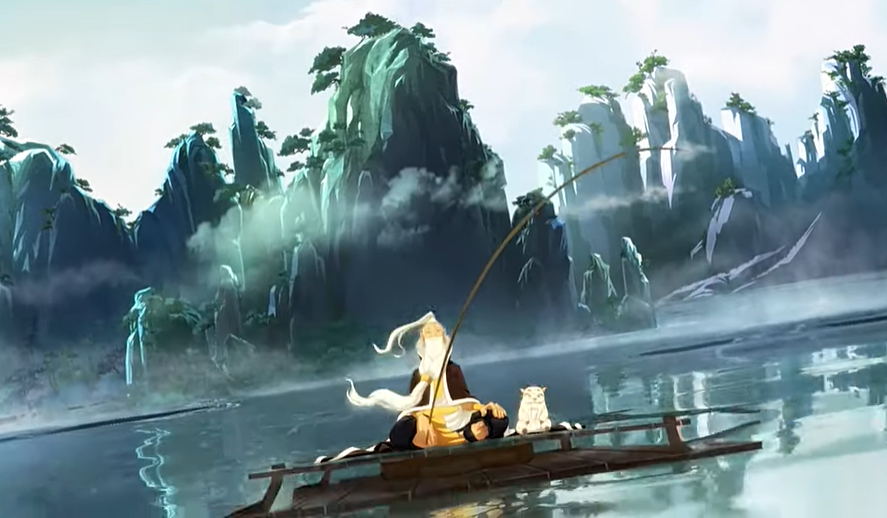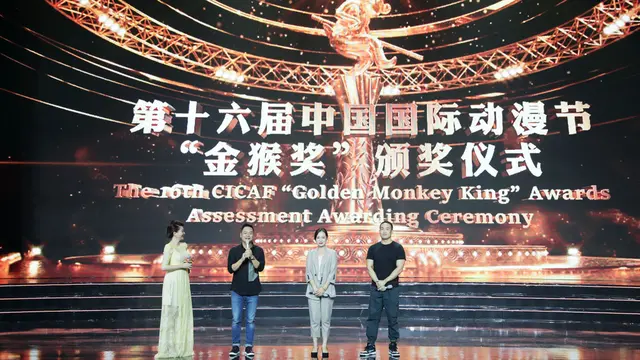
The 16th China International Cartoon and Animation Festival (CICAF) will open on Tuesday in the eastern Chinese city of Hangzhou, with the best in the industry honored with the Golden Monkey King Awards. /Credit by CICAF
**Editor's note: **Hui Han is director and associate professor at department of animation, School of Film and Animation of China Academy of Art. He is also a rater of the Golden Monkey King Awards of
the 16th China International Cartoon and Animation Festival. The article reflects the author's opinions, and not necessarily the views of CGTN.
Within three days, the highly-anticipated Chinese animated film "Jiang Ziya: Legend Of Deification," which has set a new single-day record for animation per day in China, grossed more than 800 million yuan (about 120 million U.S. dollars) as of Saturday. From "Nezha" to "Jiang Ziya," the Color Room Pictures has established a universe of Chinese mythological heroes, which will surely bring in a new capital follow for animated films.
Over the past few years, many Chinese mythical stories were adapted to movies or television series. With the successes of "Monkey King: Hero is Back" and "Nezha" by Color Room Pictures, plenty of the same genre sprung up. But the most impressive remains the previous ones.
Although Chinese audiences are more receptive to traditional Chinese heroic characters than the re-created ones, the frequent remakes of some particular Chinese traditional figures will lead to some sort of vapidity for the domestic audience who appreciate originality and linger on childhood memories.
Noticeably, the Chinese animated films have been making good use of the Chinese supernatural fictions such as
The Classic of Mountains and Seas, The Investiture of the Gods, The Three Sui Quash the Demons' Revolt
. Besides, Chinese internet literature is found being adapted into various internet drama series such asA Record of a Mortal's Journey to Immortality, creating a variety of heroic characters.
Animated films featuring Chinese traditional culture will still be popular in the near future, but in terms of character selection, to avoid similarity should be considered seriously by animation producers.
Comparing with overseas animated films, our highest-grossing homemade ones are all in the form of 3-D, far less than the categories of the European animated films, which boasts a wide spectrum of animation categories, i.e., the 3-D, the 2-D, the puppet animation, etc.
This is largely seen as a result that the Chinese audience is more used to the kind of colorful eye-feasts provided by Hollywood and Disney masterpieces. But as far as I am concerned, it's also a side effect of the unbalanced development of Chinese animation education.

A screenshot of "My Master Jiang Ziya", a graduation project of Communication University of China.
Over the past two decades of the Chinese animation education development, most animation colleges and schools focused on polishing the student's skills, but less on systematic education, innovations for the upper-stream of the industry and talent cultivation for coordination.
Due to their academic background and faculty number, many colleges have only set up courses of the 3-D software learning, stressing basic animation technology, software education and training, thus having cultivated a huge number of talents adept at working on software, which is a recognizable achievement for sure.
As an increasing number of animated works by college-level talent was recognized overseas, won prizes on various animation festivals, and drew attention, it also brought in the cutting-edged conceptions and skills for the domestic animation industry.
What's worth mentioning is that the production of the animated film "Jiang Ziya: Legend Of Deification" was encouraged by "My Master Jiang Ziya," a graduation project of the Communication University of China.
Every year, many outstanding animated works draw a large number of youths during the college graduation season. Each work reflects the creator's willingness to deliver thoughts and implications, also is featured by unique visions and extraordinary skills both in form and style. Rather a proportion of them has the potential for commercialization.
Nevertheless, colleges lack tools for tapping their potential and lack veteran investors to work with in terms of incubation and operation, which has said to be a pity left by the Chinese animation education for generations. It calls for notice and changes.
(If you want to contribute and have specific expertise, please contact us at [email protected].)
 简体中文
简体中文

